Annual Analysis of FOODplus Supermarket Performance
VerifiedAdded on 2023/04/22
|6
|2235
|128
AI Summary
The report analyses the performance of 150 FOODplus supermarkets using various descriptive and inferential statistics tools. It covers topics such as gross profit, wastage, sales variation, and more. The report concludes that the company has immense potential for growth in online sales and waste management practices.
Contribute Materials
Your contribution can guide someone’s learning journey. Share your
documents today.
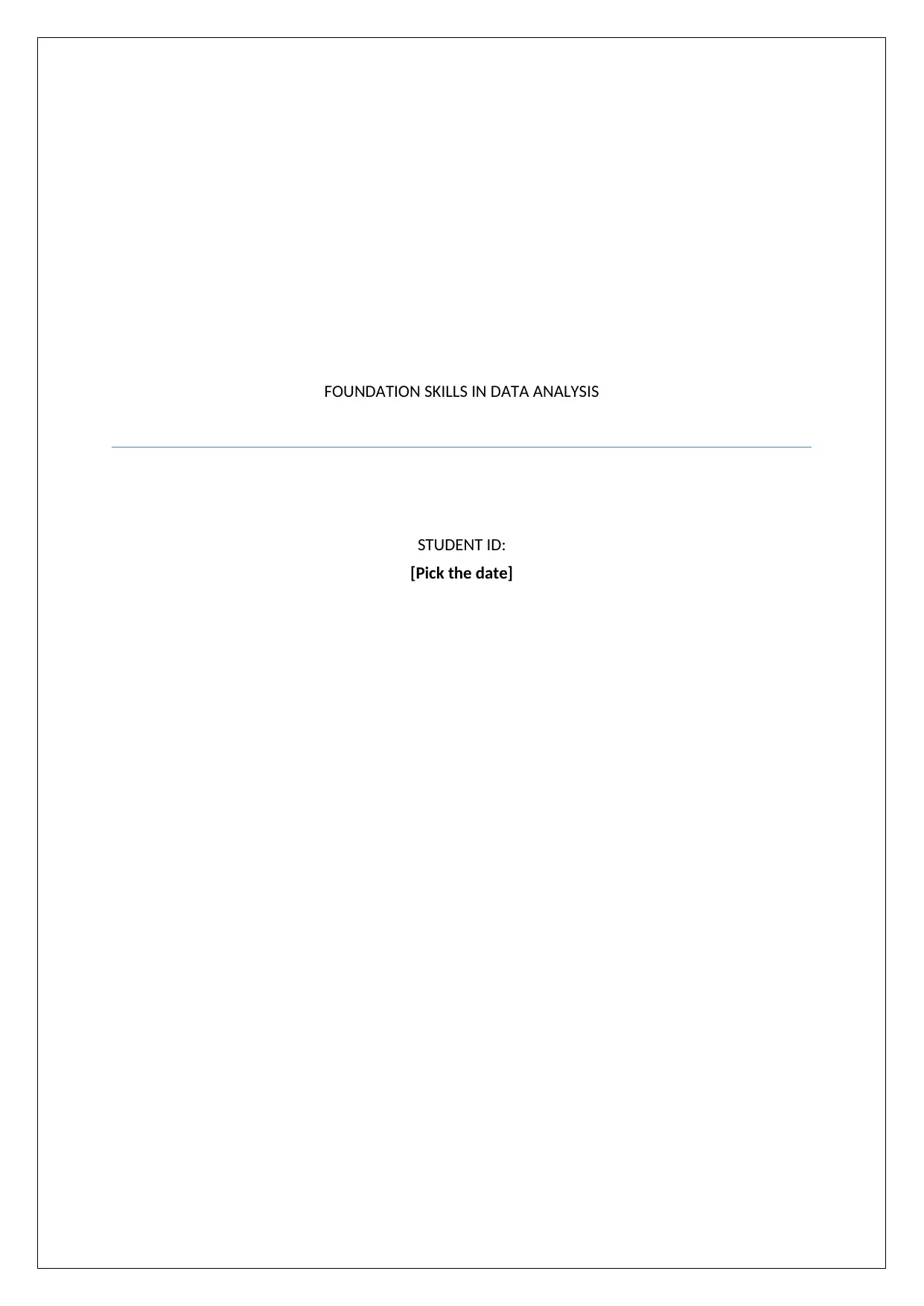
FOUNDATION SKILLS IN DATA ANALYSIS
STUDENT ID:
[Pick the date]
STUDENT ID:
[Pick the date]
Secure Best Marks with AI Grader
Need help grading? Try our AI Grader for instant feedback on your assignments.
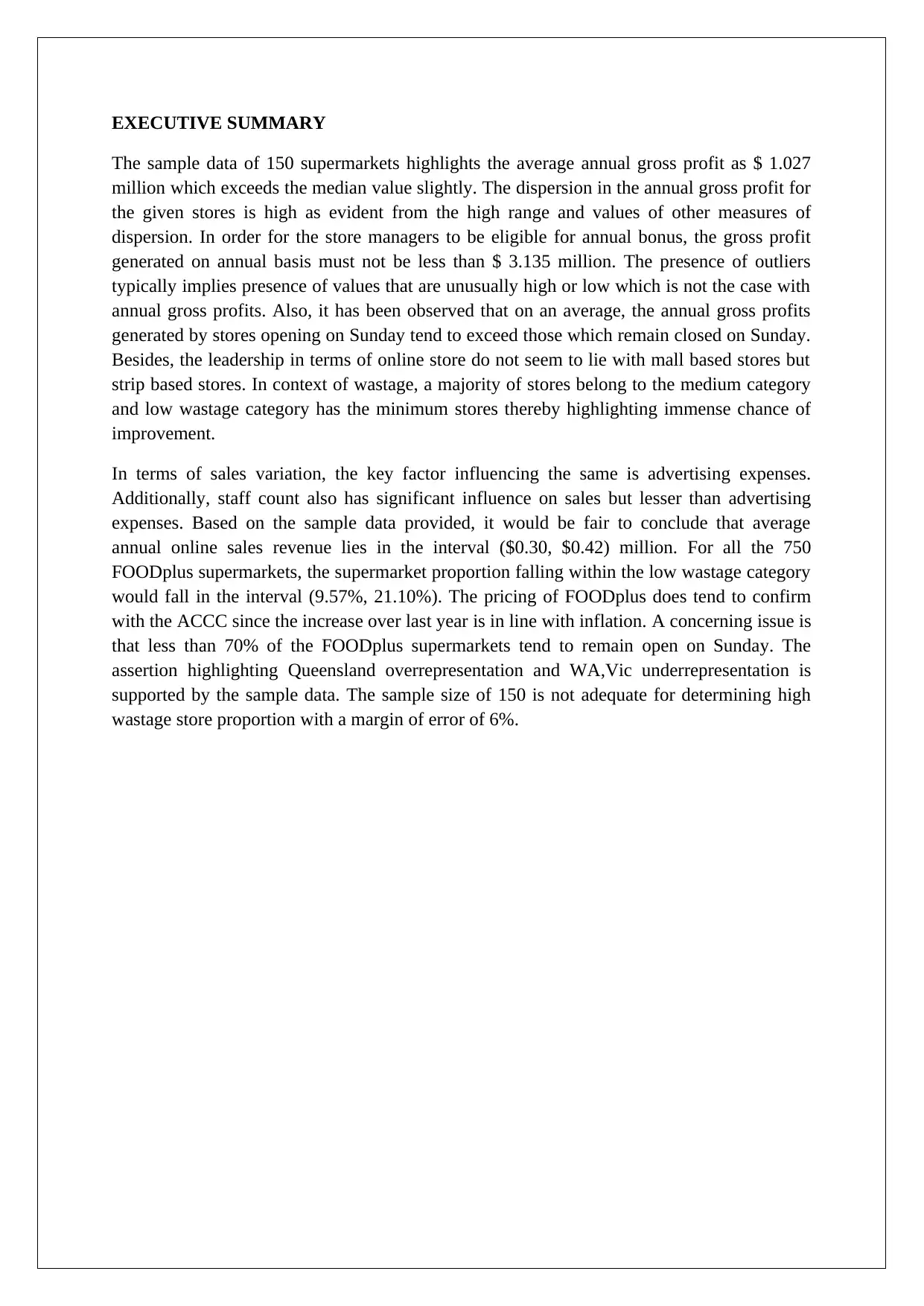
EXECUTIVE SUMMARY
The sample data of 150 supermarkets highlights the average annual gross profit as $ 1.027
million which exceeds the median value slightly. The dispersion in the annual gross profit for
the given stores is high as evident from the high range and values of other measures of
dispersion. In order for the store managers to be eligible for annual bonus, the gross profit
generated on annual basis must not be less than $ 3.135 million. The presence of outliers
typically implies presence of values that are unusually high or low which is not the case with
annual gross profits. Also, it has been observed that on an average, the annual gross profits
generated by stores opening on Sunday tend to exceed those which remain closed on Sunday.
Besides, the leadership in terms of online store do not seem to lie with mall based stores but
strip based stores. In context of wastage, a majority of stores belong to the medium category
and low wastage category has the minimum stores thereby highlighting immense chance of
improvement.
In terms of sales variation, the key factor influencing the same is advertising expenses.
Additionally, staff count also has significant influence on sales but lesser than advertising
expenses. Based on the sample data provided, it would be fair to conclude that average
annual online sales revenue lies in the interval ($0.30, $0.42) million. For all the 750
FOODplus supermarkets, the supermarket proportion falling within the low wastage category
would fall in the interval (9.57%, 21.10%). The pricing of FOODplus does tend to confirm
with the ACCC since the increase over last year is in line with inflation. A concerning issue is
that less than 70% of the FOODplus supermarkets tend to remain open on Sunday. The
assertion highlighting Queensland overrepresentation and WA,Vic underrepresentation is
supported by the sample data. The sample size of 150 is not adequate for determining high
wastage store proportion with a margin of error of 6%.
The sample data of 150 supermarkets highlights the average annual gross profit as $ 1.027
million which exceeds the median value slightly. The dispersion in the annual gross profit for
the given stores is high as evident from the high range and values of other measures of
dispersion. In order for the store managers to be eligible for annual bonus, the gross profit
generated on annual basis must not be less than $ 3.135 million. The presence of outliers
typically implies presence of values that are unusually high or low which is not the case with
annual gross profits. Also, it has been observed that on an average, the annual gross profits
generated by stores opening on Sunday tend to exceed those which remain closed on Sunday.
Besides, the leadership in terms of online store do not seem to lie with mall based stores but
strip based stores. In context of wastage, a majority of stores belong to the medium category
and low wastage category has the minimum stores thereby highlighting immense chance of
improvement.
In terms of sales variation, the key factor influencing the same is advertising expenses.
Additionally, staff count also has significant influence on sales but lesser than advertising
expenses. Based on the sample data provided, it would be fair to conclude that average
annual online sales revenue lies in the interval ($0.30, $0.42) million. For all the 750
FOODplus supermarkets, the supermarket proportion falling within the low wastage category
would fall in the interval (9.57%, 21.10%). The pricing of FOODplus does tend to confirm
with the ACCC since the increase over last year is in line with inflation. A concerning issue is
that less than 70% of the FOODplus supermarkets tend to remain open on Sunday. The
assertion highlighting Queensland overrepresentation and WA,Vic underrepresentation is
supported by the sample data. The sample size of 150 is not adequate for determining high
wastage store proportion with a margin of error of 6%.
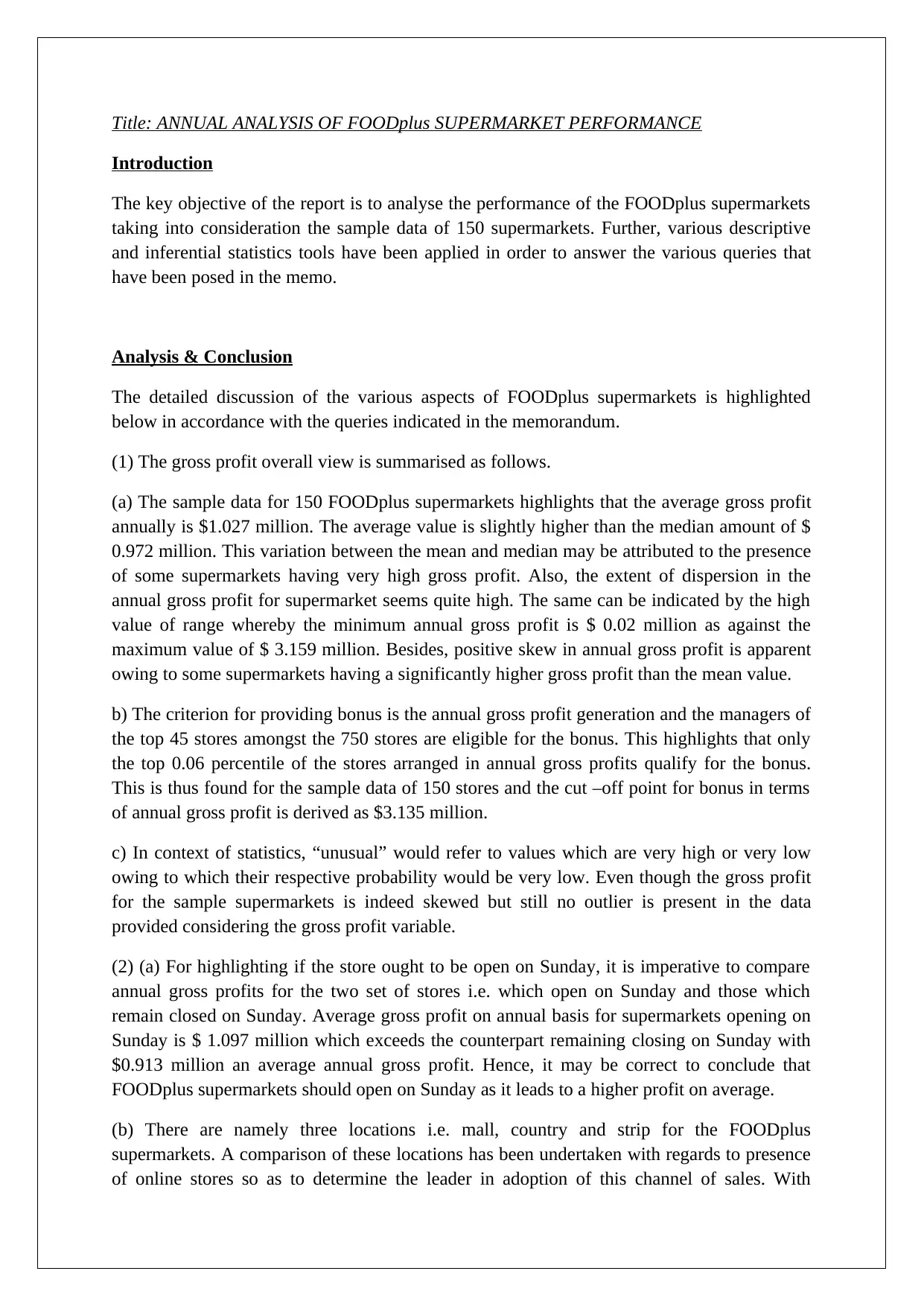
Title: ANNUAL ANALYSIS OF FOODplus SUPERMARKET PERFORMANCE
Introduction
The key objective of the report is to analyse the performance of the FOODplus supermarkets
taking into consideration the sample data of 150 supermarkets. Further, various descriptive
and inferential statistics tools have been applied in order to answer the various queries that
have been posed in the memo.
Analysis & Conclusion
The detailed discussion of the various aspects of FOODplus supermarkets is highlighted
below in accordance with the queries indicated in the memorandum.
(1) The gross profit overall view is summarised as follows.
(a) The sample data for 150 FOODplus supermarkets highlights that the average gross profit
annually is $1.027 million. The average value is slightly higher than the median amount of $
0.972 million. This variation between the mean and median may be attributed to the presence
of some supermarkets having very high gross profit. Also, the extent of dispersion in the
annual gross profit for supermarket seems quite high. The same can be indicated by the high
value of range whereby the minimum annual gross profit is $ 0.02 million as against the
maximum value of $ 3.159 million. Besides, positive skew in annual gross profit is apparent
owing to some supermarkets having a significantly higher gross profit than the mean value.
b) The criterion for providing bonus is the annual gross profit generation and the managers of
the top 45 stores amongst the 750 stores are eligible for the bonus. This highlights that only
the top 0.06 percentile of the stores arranged in annual gross profits qualify for the bonus.
This is thus found for the sample data of 150 stores and the cut –off point for bonus in terms
of annual gross profit is derived as $3.135 million.
c) In context of statistics, “unusual” would refer to values which are very high or very low
owing to which their respective probability would be very low. Even though the gross profit
for the sample supermarkets is indeed skewed but still no outlier is present in the data
provided considering the gross profit variable.
(2) (a) For highlighting if the store ought to be open on Sunday, it is imperative to compare
annual gross profits for the two set of stores i.e. which open on Sunday and those which
remain closed on Sunday. Average gross profit on annual basis for supermarkets opening on
Sunday is $ 1.097 million which exceeds the counterpart remaining closing on Sunday with
$0.913 million an average annual gross profit. Hence, it may be correct to conclude that
FOODplus supermarkets should open on Sunday as it leads to a higher profit on average.
(b) There are namely three locations i.e. mall, country and strip for the FOODplus
supermarkets. A comparison of these locations has been undertaken with regards to presence
of online stores so as to determine the leader in adoption of this channel of sales. With
Introduction
The key objective of the report is to analyse the performance of the FOODplus supermarkets
taking into consideration the sample data of 150 supermarkets. Further, various descriptive
and inferential statistics tools have been applied in order to answer the various queries that
have been posed in the memo.
Analysis & Conclusion
The detailed discussion of the various aspects of FOODplus supermarkets is highlighted
below in accordance with the queries indicated in the memorandum.
(1) The gross profit overall view is summarised as follows.
(a) The sample data for 150 FOODplus supermarkets highlights that the average gross profit
annually is $1.027 million. The average value is slightly higher than the median amount of $
0.972 million. This variation between the mean and median may be attributed to the presence
of some supermarkets having very high gross profit. Also, the extent of dispersion in the
annual gross profit for supermarket seems quite high. The same can be indicated by the high
value of range whereby the minimum annual gross profit is $ 0.02 million as against the
maximum value of $ 3.159 million. Besides, positive skew in annual gross profit is apparent
owing to some supermarkets having a significantly higher gross profit than the mean value.
b) The criterion for providing bonus is the annual gross profit generation and the managers of
the top 45 stores amongst the 750 stores are eligible for the bonus. This highlights that only
the top 0.06 percentile of the stores arranged in annual gross profits qualify for the bonus.
This is thus found for the sample data of 150 stores and the cut –off point for bonus in terms
of annual gross profit is derived as $3.135 million.
c) In context of statistics, “unusual” would refer to values which are very high or very low
owing to which their respective probability would be very low. Even though the gross profit
for the sample supermarkets is indeed skewed but still no outlier is present in the data
provided considering the gross profit variable.
(2) (a) For highlighting if the store ought to be open on Sunday, it is imperative to compare
annual gross profits for the two set of stores i.e. which open on Sunday and those which
remain closed on Sunday. Average gross profit on annual basis for supermarkets opening on
Sunday is $ 1.097 million which exceeds the counterpart remaining closing on Sunday with
$0.913 million an average annual gross profit. Hence, it may be correct to conclude that
FOODplus supermarkets should open on Sunday as it leads to a higher profit on average.
(b) There are namely three locations i.e. mall, country and strip for the FOODplus
supermarkets. A comparison of these locations has been undertaken with regards to presence
of online stores so as to determine the leader in adoption of this channel of sales. With
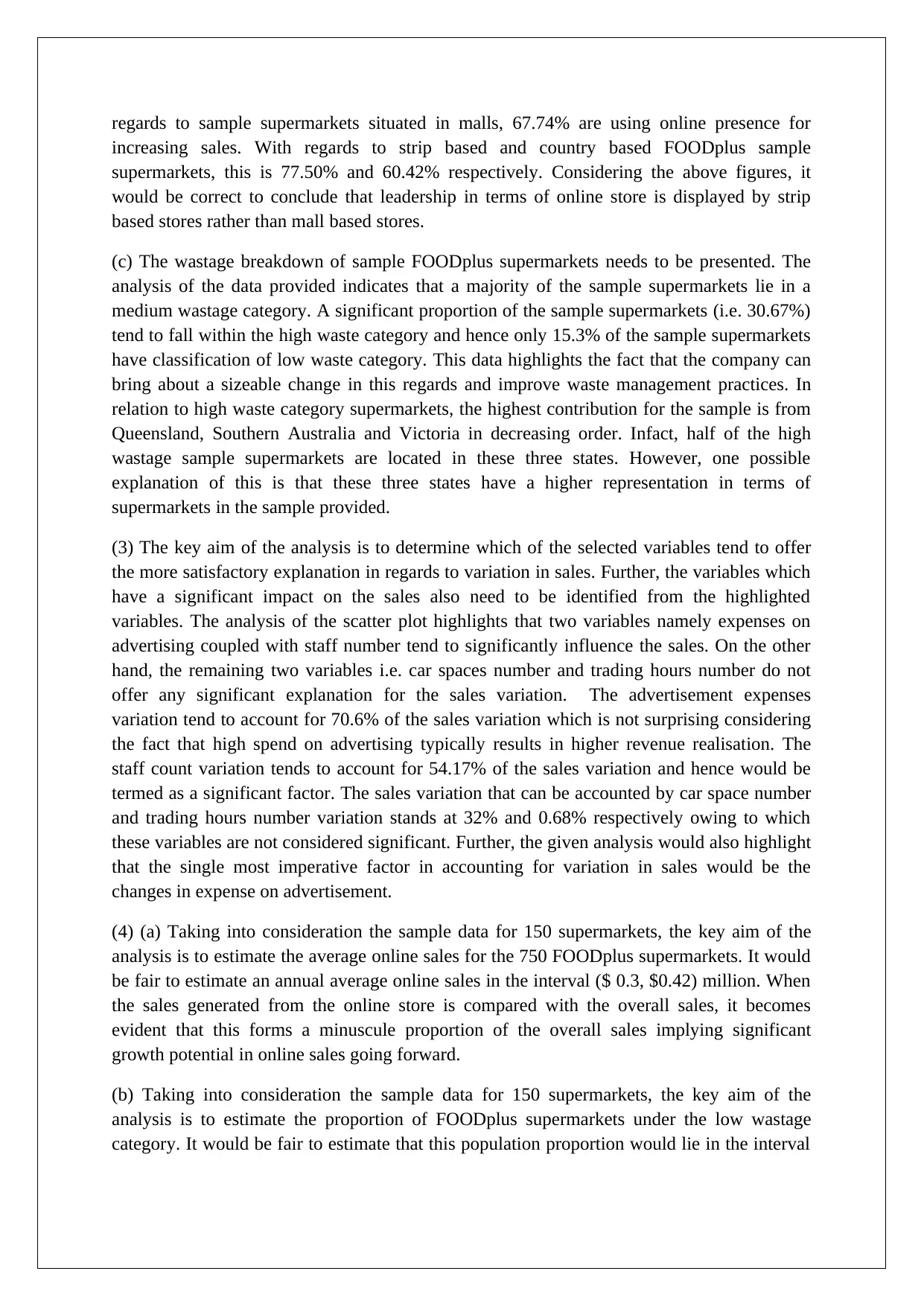
regards to sample supermarkets situated in malls, 67.74% are using online presence for
increasing sales. With regards to strip based and country based FOODplus sample
supermarkets, this is 77.50% and 60.42% respectively. Considering the above figures, it
would be correct to conclude that leadership in terms of online store is displayed by strip
based stores rather than mall based stores.
(c) The wastage breakdown of sample FOODplus supermarkets needs to be presented. The
analysis of the data provided indicates that a majority of the sample supermarkets lie in a
medium wastage category. A significant proportion of the sample supermarkets (i.e. 30.67%)
tend to fall within the high waste category and hence only 15.3% of the sample supermarkets
have classification of low waste category. This data highlights the fact that the company can
bring about a sizeable change in this regards and improve waste management practices. In
relation to high waste category supermarkets, the highest contribution for the sample is from
Queensland, Southern Australia and Victoria in decreasing order. Infact, half of the high
wastage sample supermarkets are located in these three states. However, one possible
explanation of this is that these three states have a higher representation in terms of
supermarkets in the sample provided.
(3) The key aim of the analysis is to determine which of the selected variables tend to offer
the more satisfactory explanation in regards to variation in sales. Further, the variables which
have a significant impact on the sales also need to be identified from the highlighted
variables. The analysis of the scatter plot highlights that two variables namely expenses on
advertising coupled with staff number tend to significantly influence the sales. On the other
hand, the remaining two variables i.e. car spaces number and trading hours number do not
offer any significant explanation for the sales variation. The advertisement expenses
variation tend to account for 70.6% of the sales variation which is not surprising considering
the fact that high spend on advertising typically results in higher revenue realisation. The
staff count variation tends to account for 54.17% of the sales variation and hence would be
termed as a significant factor. The sales variation that can be accounted by car space number
and trading hours number variation stands at 32% and 0.68% respectively owing to which
these variables are not considered significant. Further, the given analysis would also highlight
that the single most imperative factor in accounting for variation in sales would be the
changes in expense on advertisement.
(4) (a) Taking into consideration the sample data for 150 supermarkets, the key aim of the
analysis is to estimate the average online sales for the 750 FOODplus supermarkets. It would
be fair to estimate an annual average online sales in the interval ($ 0.3, $0.42) million. When
the sales generated from the online store is compared with the overall sales, it becomes
evident that this forms a minuscule proportion of the overall sales implying significant
growth potential in online sales going forward.
(b) Taking into consideration the sample data for 150 supermarkets, the key aim of the
analysis is to estimate the proportion of FOODplus supermarkets under the low wastage
category. It would be fair to estimate that this population proportion would lie in the interval
increasing sales. With regards to strip based and country based FOODplus sample
supermarkets, this is 77.50% and 60.42% respectively. Considering the above figures, it
would be correct to conclude that leadership in terms of online store is displayed by strip
based stores rather than mall based stores.
(c) The wastage breakdown of sample FOODplus supermarkets needs to be presented. The
analysis of the data provided indicates that a majority of the sample supermarkets lie in a
medium wastage category. A significant proportion of the sample supermarkets (i.e. 30.67%)
tend to fall within the high waste category and hence only 15.3% of the sample supermarkets
have classification of low waste category. This data highlights the fact that the company can
bring about a sizeable change in this regards and improve waste management practices. In
relation to high waste category supermarkets, the highest contribution for the sample is from
Queensland, Southern Australia and Victoria in decreasing order. Infact, half of the high
wastage sample supermarkets are located in these three states. However, one possible
explanation of this is that these three states have a higher representation in terms of
supermarkets in the sample provided.
(3) The key aim of the analysis is to determine which of the selected variables tend to offer
the more satisfactory explanation in regards to variation in sales. Further, the variables which
have a significant impact on the sales also need to be identified from the highlighted
variables. The analysis of the scatter plot highlights that two variables namely expenses on
advertising coupled with staff number tend to significantly influence the sales. On the other
hand, the remaining two variables i.e. car spaces number and trading hours number do not
offer any significant explanation for the sales variation. The advertisement expenses
variation tend to account for 70.6% of the sales variation which is not surprising considering
the fact that high spend on advertising typically results in higher revenue realisation. The
staff count variation tends to account for 54.17% of the sales variation and hence would be
termed as a significant factor. The sales variation that can be accounted by car space number
and trading hours number variation stands at 32% and 0.68% respectively owing to which
these variables are not considered significant. Further, the given analysis would also highlight
that the single most imperative factor in accounting for variation in sales would be the
changes in expense on advertisement.
(4) (a) Taking into consideration the sample data for 150 supermarkets, the key aim of the
analysis is to estimate the average online sales for the 750 FOODplus supermarkets. It would
be fair to estimate an annual average online sales in the interval ($ 0.3, $0.42) million. When
the sales generated from the online store is compared with the overall sales, it becomes
evident that this forms a minuscule proportion of the overall sales implying significant
growth potential in online sales going forward.
(b) Taking into consideration the sample data for 150 supermarkets, the key aim of the
analysis is to estimate the proportion of FOODplus supermarkets under the low wastage
category. It would be fair to estimate that this population proportion would lie in the interval
Secure Best Marks with AI Grader
Need help grading? Try our AI Grader for instant feedback on your assignments.
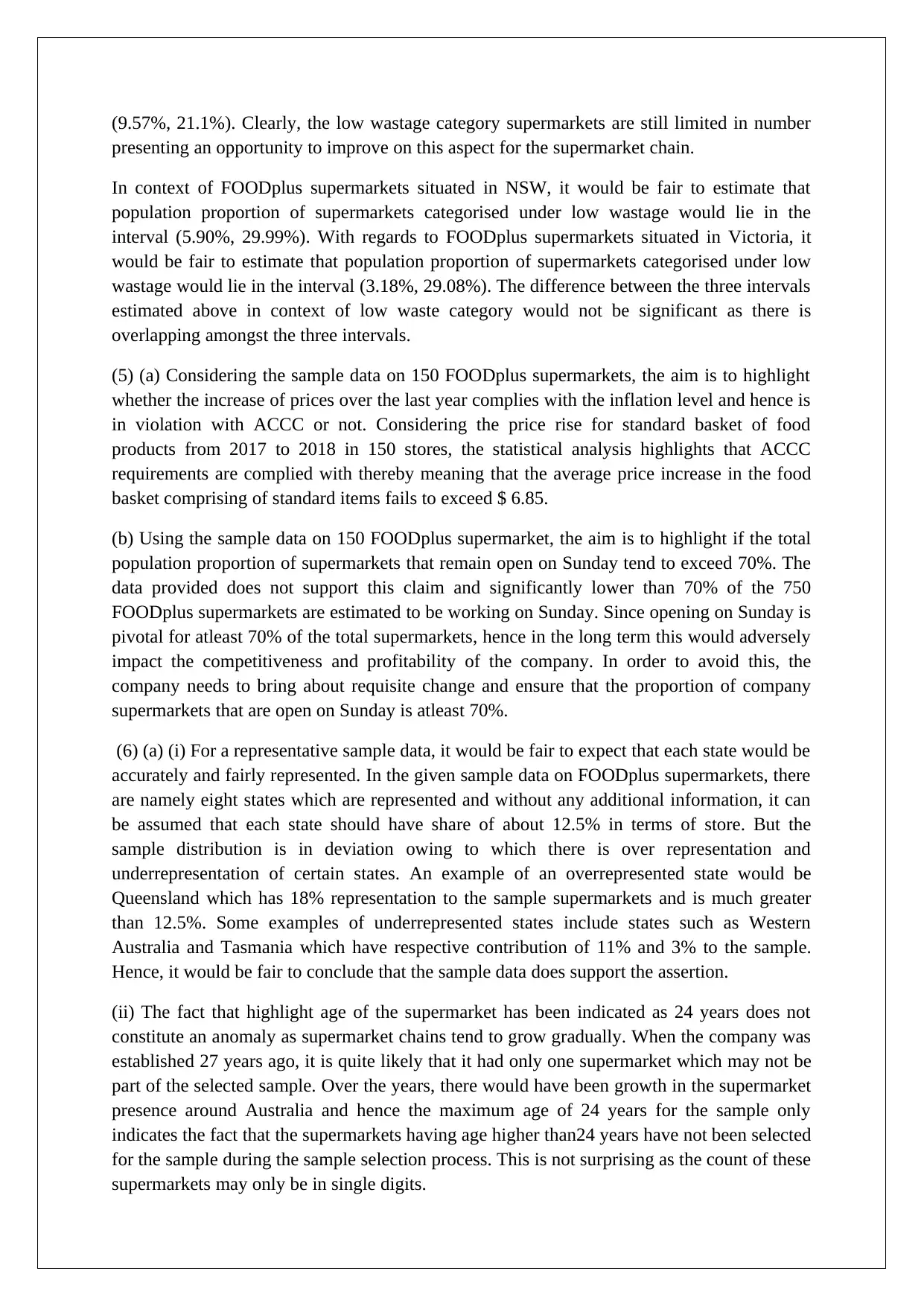
(9.57%, 21.1%). Clearly, the low wastage category supermarkets are still limited in number
presenting an opportunity to improve on this aspect for the supermarket chain.
In context of FOODplus supermarkets situated in NSW, it would be fair to estimate that
population proportion of supermarkets categorised under low wastage would lie in the
interval (5.90%, 29.99%). With regards to FOODplus supermarkets situated in Victoria, it
would be fair to estimate that population proportion of supermarkets categorised under low
wastage would lie in the interval (3.18%, 29.08%). The difference between the three intervals
estimated above in context of low waste category would not be significant as there is
overlapping amongst the three intervals.
(5) (a) Considering the sample data on 150 FOODplus supermarkets, the aim is to highlight
whether the increase of prices over the last year complies with the inflation level and hence is
in violation with ACCC or not. Considering the price rise for standard basket of food
products from 2017 to 2018 in 150 stores, the statistical analysis highlights that ACCC
requirements are complied with thereby meaning that the average price increase in the food
basket comprising of standard items fails to exceed $ 6.85.
(b) Using the sample data on 150 FOODplus supermarket, the aim is to highlight if the total
population proportion of supermarkets that remain open on Sunday tend to exceed 70%. The
data provided does not support this claim and significantly lower than 70% of the 750
FOODplus supermarkets are estimated to be working on Sunday. Since opening on Sunday is
pivotal for atleast 70% of the total supermarkets, hence in the long term this would adversely
impact the competitiveness and profitability of the company. In order to avoid this, the
company needs to bring about requisite change and ensure that the proportion of company
supermarkets that are open on Sunday is atleast 70%.
(6) (a) (i) For a representative sample data, it would be fair to expect that each state would be
accurately and fairly represented. In the given sample data on FOODplus supermarkets, there
are namely eight states which are represented and without any additional information, it can
be assumed that each state should have share of about 12.5% in terms of store. But the
sample distribution is in deviation owing to which there is over representation and
underrepresentation of certain states. An example of an overrepresented state would be
Queensland which has 18% representation to the sample supermarkets and is much greater
than 12.5%. Some examples of underrepresented states include states such as Western
Australia and Tasmania which have respective contribution of 11% and 3% to the sample.
Hence, it would be fair to conclude that the sample data does support the assertion.
(ii) The fact that highlight age of the supermarket has been indicated as 24 years does not
constitute an anomaly as supermarket chains tend to grow gradually. When the company was
established 27 years ago, it is quite likely that it had only one supermarket which may not be
part of the selected sample. Over the years, there would have been growth in the supermarket
presence around Australia and hence the maximum age of 24 years for the sample only
indicates the fact that the supermarkets having age higher than24 years have not been selected
for the sample during the sample selection process. This is not surprising as the count of these
supermarkets may only be in single digits.
presenting an opportunity to improve on this aspect for the supermarket chain.
In context of FOODplus supermarkets situated in NSW, it would be fair to estimate that
population proportion of supermarkets categorised under low wastage would lie in the
interval (5.90%, 29.99%). With regards to FOODplus supermarkets situated in Victoria, it
would be fair to estimate that population proportion of supermarkets categorised under low
wastage would lie in the interval (3.18%, 29.08%). The difference between the three intervals
estimated above in context of low waste category would not be significant as there is
overlapping amongst the three intervals.
(5) (a) Considering the sample data on 150 FOODplus supermarkets, the aim is to highlight
whether the increase of prices over the last year complies with the inflation level and hence is
in violation with ACCC or not. Considering the price rise for standard basket of food
products from 2017 to 2018 in 150 stores, the statistical analysis highlights that ACCC
requirements are complied with thereby meaning that the average price increase in the food
basket comprising of standard items fails to exceed $ 6.85.
(b) Using the sample data on 150 FOODplus supermarket, the aim is to highlight if the total
population proportion of supermarkets that remain open on Sunday tend to exceed 70%. The
data provided does not support this claim and significantly lower than 70% of the 750
FOODplus supermarkets are estimated to be working on Sunday. Since opening on Sunday is
pivotal for atleast 70% of the total supermarkets, hence in the long term this would adversely
impact the competitiveness and profitability of the company. In order to avoid this, the
company needs to bring about requisite change and ensure that the proportion of company
supermarkets that are open on Sunday is atleast 70%.
(6) (a) (i) For a representative sample data, it would be fair to expect that each state would be
accurately and fairly represented. In the given sample data on FOODplus supermarkets, there
are namely eight states which are represented and without any additional information, it can
be assumed that each state should have share of about 12.5% in terms of store. But the
sample distribution is in deviation owing to which there is over representation and
underrepresentation of certain states. An example of an overrepresented state would be
Queensland which has 18% representation to the sample supermarkets and is much greater
than 12.5%. Some examples of underrepresented states include states such as Western
Australia and Tasmania which have respective contribution of 11% and 3% to the sample.
Hence, it would be fair to conclude that the sample data does support the assertion.
(ii) The fact that highlight age of the supermarket has been indicated as 24 years does not
constitute an anomaly as supermarket chains tend to grow gradually. When the company was
established 27 years ago, it is quite likely that it had only one supermarket which may not be
part of the selected sample. Over the years, there would have been growth in the supermarket
presence around Australia and hence the maximum age of 24 years for the sample only
indicates the fact that the supermarkets having age higher than24 years have not been selected
for the sample during the sample selection process. This is not surprising as the count of these
supermarkets may only be in single digits.

(b) To ensure that annual gross profit is estimated within $ 120,000, the minimum sample
size ought to be 148 which is lesser than the available sample of 150 supermarkets. But, with
regards to estimation of high wastage stores proportion within 6%, the minimum sample size
ought to be 227 which is greater than the available sample of 150 supermarkets. As a result, a
higher sample would be required for the above estimation.
size ought to be 148 which is lesser than the available sample of 150 supermarkets. But, with
regards to estimation of high wastage stores proportion within 6%, the minimum sample size
ought to be 227 which is greater than the available sample of 150 supermarkets. As a result, a
higher sample would be required for the above estimation.
1 out of 6
Related Documents
Your All-in-One AI-Powered Toolkit for Academic Success.
+13062052269
info@desklib.com
Available 24*7 on WhatsApp / Email
![[object Object]](/_next/static/media/star-bottom.7253800d.svg)
Unlock your academic potential
© 2024 | Zucol Services PVT LTD | All rights reserved.





